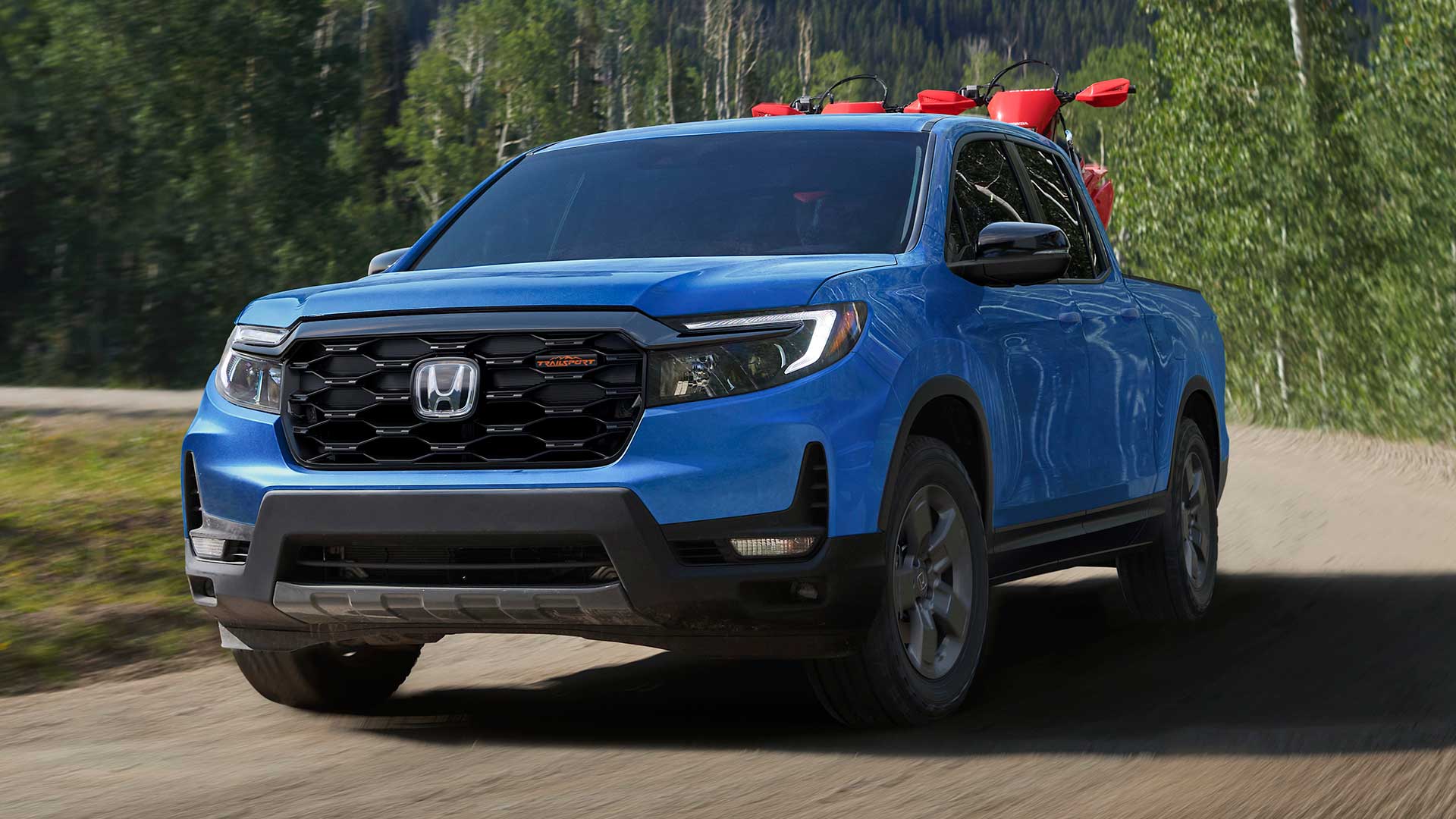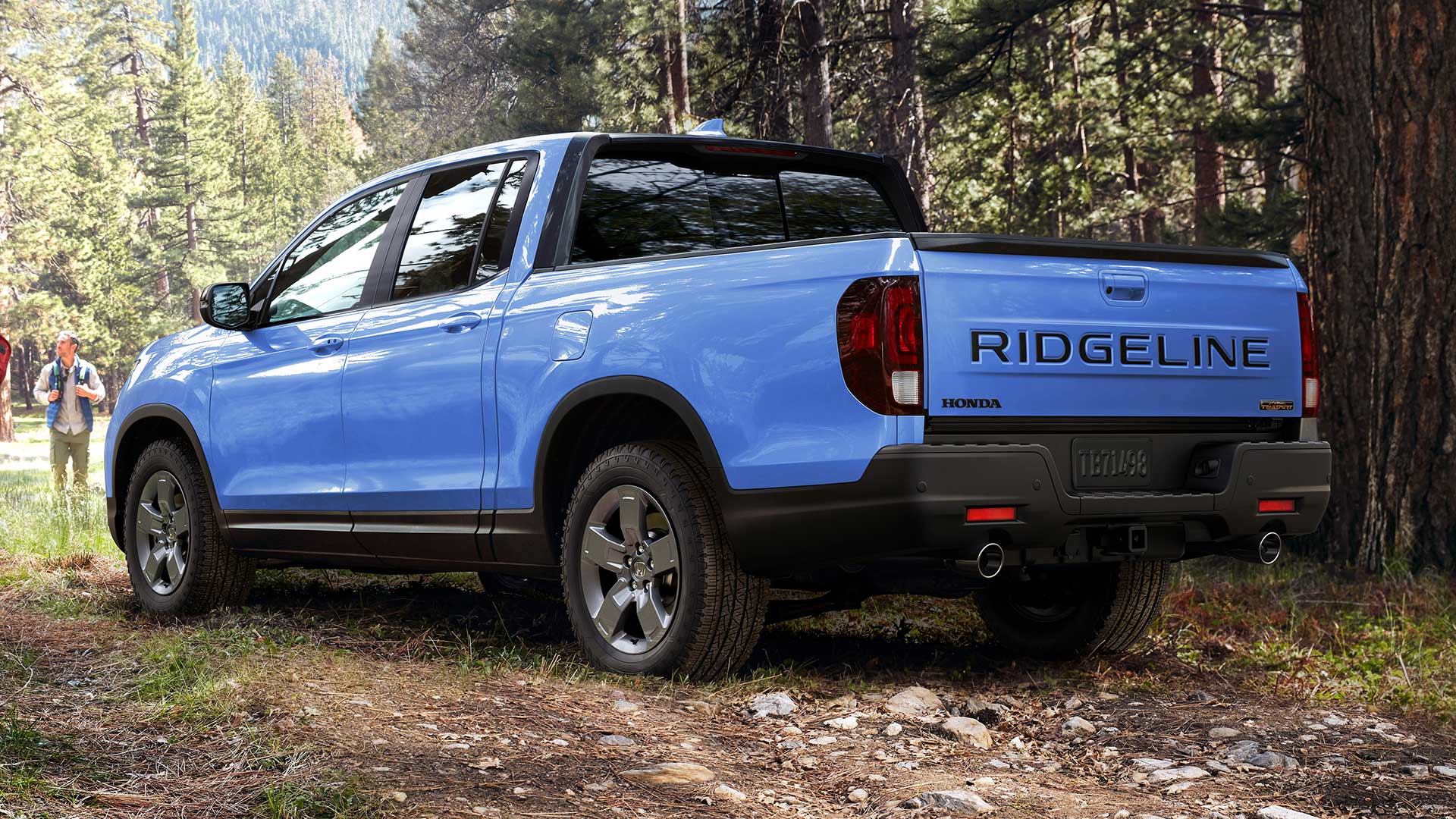2010 Chevrolet Equinox
As the “new” GM gears up, it’s clear that certain vehicles will be key to its success. The 2010 Chevrolet Equinox is the first such vehicle. Now this 5-passenger compact crossover utility returns with a stem-to-stern overhaul and a focus on higher fuel economy, all to be a stronger competitor in a segment pioneered by the Toyota RAV-4 and Honda CR-V. So let’s see if Equinox can lead the General’s march back to success.
The second-generation 2010 Chevrolet Equinox is built on an updated Theta architecture, shared with the upcoming GMC Terrain. Shorter than last year, its very attractive styling draws heavily from the larger Traverse crossover. That includes a front fascia defined by a two-tier bowtie grille, wraparound headlamps, and available fog lights. The sleek profile is accentuated by a thick, forward-leaning C-pillar and the appearance of wrap-around glass.
But it’s powertrains with class leading economy that really makes the Equinox a standout. Standard is a 2.4-liter Ecotec I4 with advanced direct-fuel injection. Ratings are 182 horsepower, almost as much as last year’s standard V6, with 172 pound-feet of torque. Coupled to a 6-speed automatic, in front-wheel drive form, it boasts Government Fuel Economy ratings of 22 city/32 highway on regular gas. The highway number beats all other compact crossovers including the RAV4, the CR-V, and even the Ford Escape Hybrid. All-wheel drive drops the highway number to a still stellar 29. The transmission’s “eco” mode alters shift points for best fuel economy. Interstate cruising range is a bladder-busting 600 miles.
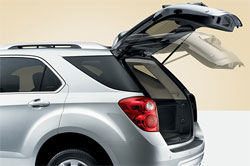 Optional is a direct-injected 3.0-liter V6 with 264 horsepower and 222 pound-feet of torque. With a 6-speed and front-drive, fuel economy ratings are a more normal 18 City/25 Highway on Regular. We spent our first outings in the Equinox on the twisty roads west of Plymouth, Michigan. The Equinox 2.4 did exhibit a moderate strain under hard acceleration, but it was no worse than other I4 compact crossovers. With a respectable zero to 60 time of 8.7 seconds, this big four is more than able to haul a full load. However, maximum trailer tow of 3,500 pounds requires the V 6.
Optional is a direct-injected 3.0-liter V6 with 264 horsepower and 222 pound-feet of torque. With a 6-speed and front-drive, fuel economy ratings are a more normal 18 City/25 Highway on Regular. We spent our first outings in the Equinox on the twisty roads west of Plymouth, Michigan. The Equinox 2.4 did exhibit a moderate strain under hard acceleration, but it was no worse than other I4 compact crossovers. With a respectable zero to 60 time of 8.7 seconds, this big four is more than able to haul a full load. However, maximum trailer tow of 3,500 pounds requires the V 6.
A stiffer chassis with wider front track aids the all-independent suspended Equinox towards excellent road manners. Ride is well-controlled, easily conquering the broken and bumpy Michigan pavement. The cabin is unusually quiet too, thanks to a low drag coefficient and Active Noise Cancellation. Equinox comes with discs brakes with ABS and Brake Assist. Hill Start Assist, stability, and traction control further the active safety equation.
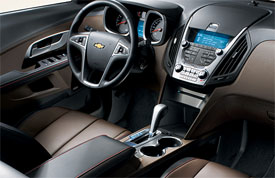 The interior of the Equinox is even more head-turning than the exterior. Not at all utilitarian, it follows the twin-cockpit theme of the Malibu and Camaro. The eye-catching instrument panel features blue lighting and a floating center stack for a truly unique appeal within the segment. Two-tone color schemes and excellent fit and finish provide an added dose of style.
The interior of the Equinox is even more head-turning than the exterior. Not at all utilitarian, it follows the twin-cockpit theme of the Malibu and Camaro. The eye-catching instrument panel features blue lighting and a floating center stack for a truly unique appeal within the segment. Two-tone color schemes and excellent fit and finish provide an added dose of style.
Seats have a more upscale look and feel too, especially when dressed in perforated leather and red stitching. A tilt/telescoping steering wheel with cruise controls is standard. The nominal six-speaker CD stereo can be upgraded to an eight-speaker Pioneer system on up-level trims. There’s also a 40-gig hard drive and Bluetooth.
Available is a rear view camera displayed in the rear view mirror. It really helps overcome the otherwise restricted rear vision. The split-folding rear bench seat now reclines. It retains fore and aft adjustment, a full eight inches, so legroom is also class best. And to keep the kids occupied, there’s an available twin-screen rear DVD system. But with so much people space, something had to give. Its 31.4 cubic feet of cargo volume behind the back seat is less than CR-V and RAV-4. With rear seats folded, that space expands to 63.7, but that’s still below average for its class. But this isn’t: the first programmable power liftgate available for a small crossover. Besides full open, it can be set for a lower opening to avoid contact with a garage ceiling.
With so much to offer, we were also surprised that Equinox has a lower price than last year, starting at $23,185 for the LS, $24,105 for the LT, and $28,790 for the up level LTZ. All-wheel drive adds $1750 more. With upscale styling and interior appointments, class leading fuel-efficiency, and a good overall value, the new 2010 Chevrolet Equinox gives RAV-4 and CRV something new to aim for. As for doing its part for a “new” GM? Well, the Equinox has all the marks of a winner!
Specifications
- Engine: 2.4-Liter Ecotec I4
- Horsepower: 182
- Torque: 172 Lb Feet
- 0-60 MPH: 8.7 Seconds
- EPA: 22 MPG City/ 32 MPG Highway
2024 Honda Ridgeline TrailSport
It Does Truck-Like Things Better Than Ever
Honda brought something truly unique to the pickup truck scene when their mid-size Ridgeline debuted for 2006. In 2017, it moved towards becoming a little more true truck-like, both in form and capability, now with yet another step in that direction for 2024. So, let’s see if the Ridgeline is really hitting its stride.
For 2024, it’s all about making this Honda Ridgeline better than ever. There are styling tweaks outside, along with tech and functional improvements inside, but the biggest news is the Ridgeline has now joined Honda’s TrailSport family of off-road inspired vehicles. This more-true-trucklike, second-gen Ridgeline been around since 2017, receiving periodic updates over the years; but joining the TrailSport family is the biggest leap yet.
Primarily, the TrailSport transformation includes General Grabber all-terrain tires, mounted on new Pewter Gray 18-inch wheels, steel underbody protection, and retuning the strut front, and multi-link rear suspension for added wheel articulation. And while we always appreciate the additional traction of off-road tires, the Ridgeline’s standard i-VTM4 all-wheel drive, with Intelligent Traction Management and snow, sand, and mud settings, was already quite capable of handling all but the most extreme off-roading, ground clearance of just 7.6 inches being it’s only real hinderance.
A 3.5-liter V6 remains under the hood as it has since the Ridgeline debuted for 2006; the current version outputs 280 horsepower and 262 lb-ft of torque, plenty enough muscle to handle its 5,000-lbs. towing capacity. A nine-speed automatic transmission with paddle shifters and bevy of push and pull buttons on the console replaced the six-speed automatic back in 2020.
In addition to adding TrailSport capability, a big focus for this update was making it more user-friendly inside, starting with the central touchscreen growing from 8 to 9 inches. It also gets faster processing speeds, menus have been simplified, and the native navigation system is improved with better graphics. It’s accompanied by a new digital instrument cluster, along with an upgraded center console with more storage space. Unique TrailSport touches include heavy duty floormats, leather-trimmed seats, orange stitching throughout the cabin, and orange ambient lighting.
The Ridgeline continues to offer things available nowhere else in the pickup truck market.
Exterior styling doesn’t exactly shout “macho big rig coming your way,” but the more vertical face and larger grille that arrived for 2021, along with this year’s added TrailSport elements, do continue to toughen up the Ridgeline’s image. The 5’4” bed remains highly functional with no large wheel well intrusions, multiple tie-downs points, lighting and even speakers. And of course, the Ridgeline continues to offer things available nowhere else in the pickup truck market, like the dual-action tailgate, and large, lockable, drainable, underbed storage. Not to mention being able to drive around in true car-like comfort, something we took full advantage of on our way to our Mason Dixon Dragway test track.
There was great grip off the line, with full power arriving smoothly but quickly, helping us to get to 60 in 7.0 seconds flat, a tenth quicker than the last Ridgeline we tested. That power delivery stayed fairly consistent the whole way down the track, barely interrupted by the nine-speed automatic’s smooth shifting. Our best quarter-mile run was 15.5 seconds at 90 mph.
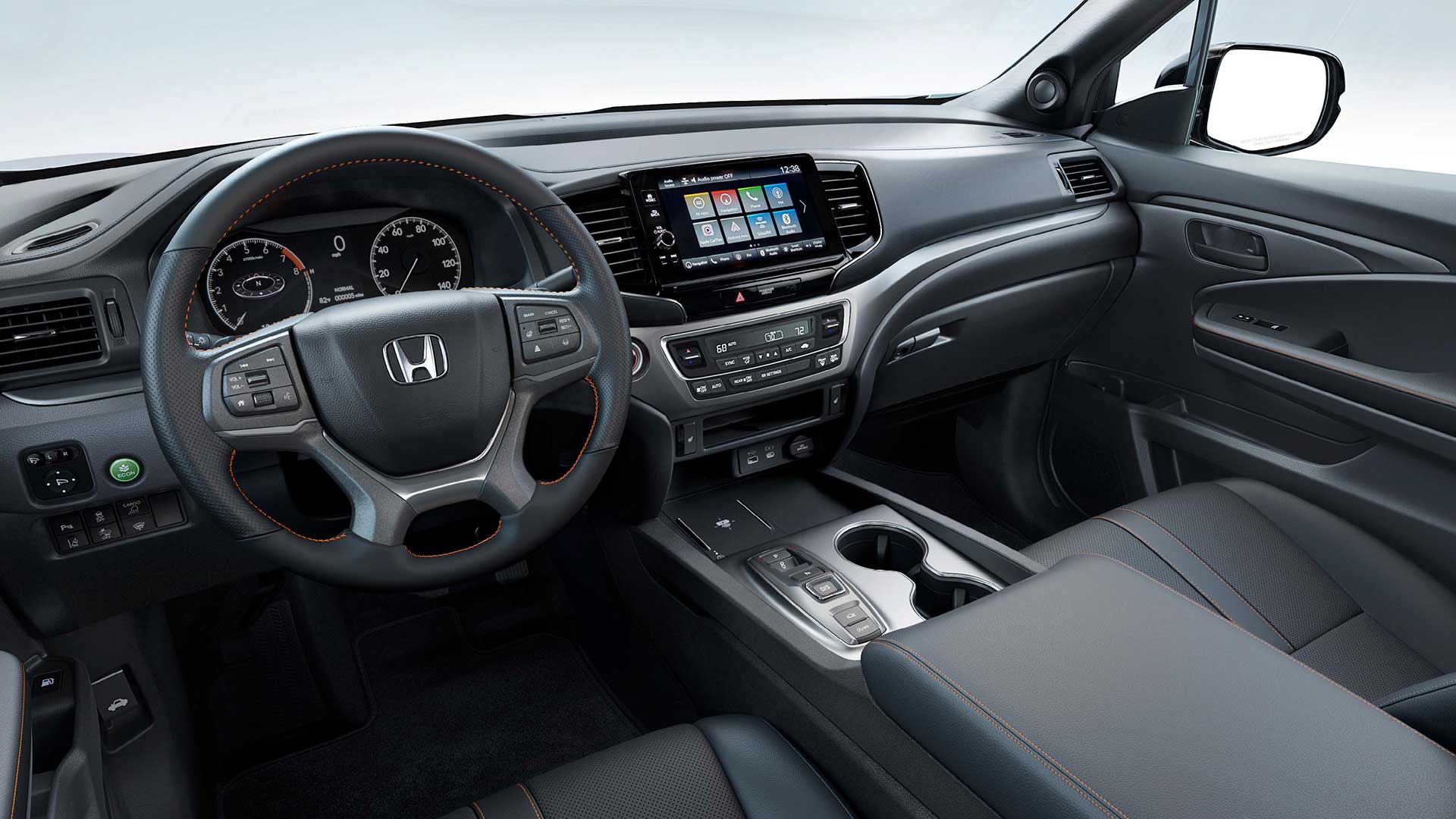
The revised suspension and knobbier tires didn’t really seem to add or detract from handling prowess, as it felt as solid, nimble, and car-like as it always has through our cone course. Perhaps a little less stiff than before, but good feedback, tight steering, and minimal body roll for a pickup, made for a very confidence inspiring experience. In our braking test, we stopped in a respectable average of 123 feet from 60, with only moderate amounts of nosedive and good feel through the pedal.
There is, however, a slight reduction in Government Fuel Economy Ratings with the all-terrain tires; 18-City, 23-Highway, and 20-Combined, our average, right on, at 20.4 mpg of Regular. That’s a slightly below average Energy Impact Score of 14.9 barrels of yearly oil use, with CO2 emissions of 7.4 tons.
TrailSport pricing falls in line just under the Ridgeline’s top Black Edition trim with a starting price of $46,375, about five grand over a base Ridgeline Sport.
So, whether you consider the Honda Ridgeline to be a “real” truck or not, this ruggedly smooth 2024 TrailSport does truck-like things better than ever. And we’re not just talking about the slight upgrade in off-road performance, we’re talking about a flexible bed to help you get chores done, and the ability to tow or haul with comfort and flexibility other trucks can only wish for. It’s why the Ridgeline brings more first-time buyers to Honda than any other vehicle, and why it continues to be a great choice in the growing midsize truck realm.
Specifications
- Engine: 3.5-liter V6
- Transmission: 9-speed automatic
- Horsepower: 280
- Torque: 262 lb-ft
- EPA: 18 City | 23 Highway | 20 Combined
- 0-60 mph: 7.0 seconds
- 1/4 Mile: 15.5 seconds at 90 mph
- 60-0 Braking (avg): 123 feet
- MW Fuel Economy: 20.4 mpg (Regular)
- Max Towing Capacity: 5,000-lbs








